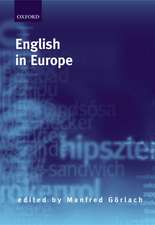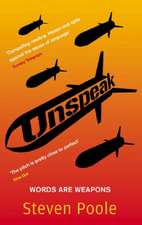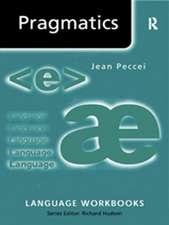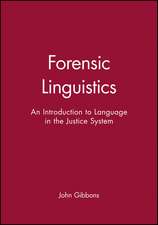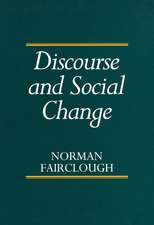Sex in Language: Euphemistic and Dysphemistic Metaphors in Internet forums
Autor Eliecer Crespo-Fernándezen Limba Engleză Paperback – 22 feb 2017
| Toate formatele și edițiile | Preț | Express |
|---|---|---|
| Paperback (1) | 217.82 lei 6-8 săpt. | |
| Bloomsbury Publishing – 22 feb 2017 | 217.82 lei 6-8 săpt. | |
| Hardback (1) | 773.81 lei 6-8 săpt. | |
| Bloomsbury Publishing – 26 aug 2015 | 773.81 lei 6-8 săpt. |
Preț: 217.82 lei
Preț vechi: 244.83 lei
-11% Nou
Puncte Express: 327
Preț estimativ în valută:
41.68€ • 43.61$ • 34.62£
41.68€ • 43.61$ • 34.62£
Carte tipărită la comandă
Livrare economică 03-17 aprilie
Preluare comenzi: 021 569.72.76
Specificații
ISBN-13: 9781350024267
ISBN-10: 1350024260
Pagini: 248
Dimensiuni: 156 x 234 x 20 mm
Greutate: 0.35 kg
Ediția:NIPPOD
Editura: Bloomsbury Publishing
Colecția Bloomsbury Academic
Locul publicării:London, United Kingdom
ISBN-10: 1350024260
Pagini: 248
Dimensiuni: 156 x 234 x 20 mm
Greutate: 0.35 kg
Ediția:NIPPOD
Editura: Bloomsbury Publishing
Colecția Bloomsbury Academic
Locul publicării:London, United Kingdom
Caracteristici
Foreword by Keith Allan, Emeritus Professor of Linguistics at Monash University, Australia, who is a world renowned expert in the field of taboo, euphemism and dysphemism.
Notă biografică
Eliecer Crespo-Fernandez is Lecturer at the Department of Modern Languages, University of Castile-La Mancha, Spain.
Cuprins
Foreword by Keith Allan, Emeritus Professor of Linguistics at Monash University, AustraliaPrefaceAcknowledgementsConventions in the TextIntroductionPart I: Metaphor, Euphemism and Dysphemism1. Euphemism and Dysphemism along Cognitive Lines2. The Cognitive Dimension of Euphemism and DysphemismPart II: Sex-Related Metaphors in Internet Forums3. Euphemistic Metaphors 4. Dysphemistic Metaphors 5. Conclusions and Final Remarks Appendix I: Euphemistic Metaphors Classified by Source DomainAppendix II: Dysphemistic Metaphors Classified by Source DomainReferencesIndex
Recenzii
Crespo-Fernández's book is an interesting contribution to the field of linguistic taboo and conceptual metaphor and has insightful reflections at the semantic, pragmatic and cultural levels. ... [His] analyses provide critical insights into heteronormative discourses present in metaphorical expressions. ... These results could contribute to understanding gender conflicts, which makes Sex in Language a recommendable read both inside and outside of the academic community.
I strongly believe that [Crespo-Fernández's] analysis of the 283 euphemistic and dysphemistic metaphorical items offers significant and valid results regarding the way sexual topics are conceptualized in English and American cultures. ... Sex in Language makes a useful contribution to current research in language, cognition and sexuality. It is well-structured, the author uses up-to-date literature and, as Keith Allan recognizes in the foreword, it is 'entertaining to read'. ... This book will be of interest to readers working in diverse areas of English linguistics.
Sex in Language is an impressive volume ... The great number of examples and illustrations which the author provides makes the manuscript extremely attractive. ... Written in an accessible style, this is a book that allows the reader to get familiar with the theoretical background affecting metaphors, X-phemisms and cognitive linguistics in general, in which the author goes a step further than traditional lexical approaches applied to this type of study.
The focus on and analysis of metaphors used in speaking about sexual body parts, effluvia, acts, and accessories is the main strength of the present work .. Sex in Language is entertaining to read
Clearly structured, well-argued and makes an important contribution to the sociolinguistic and pragmatic research field. It is certain to find a wide readership among scholars and students of languages, linguistics and social theory. I strongly recommend it.
The reader will be immersed in both the highest and most up-to-date academic theories on metaphor and euphemism as well as the actual (and sometimes inappropriate) language people use in internet forums on sex. It fills a gap in the literature on the language about sex and sexual relations.
Eliecer Crespo explores the metaphorical motivation of the language used to talk about such a pervasive, yet 'uncomfortable', topic as sex, and does so with a scholarly rigor highly commendable. The book offers an exhaustive discussion on the metaphorical motivation of the euphemistic and dysphemistic strategies real people use to discuss sex in real interaction. By combining insights and methods from such diverse approaches as discourse analysis, cognitive metaphor theory, corpus linguistics, appraisal theory and pragmatics, Crespo goes beyond the lexical approach too often adopted in research on the figurative motivation of taboo-induced expressions and avoidance strategies to provide a full account of the (inter)personal, pragmatic, and socio-cultural dimension of metaphor and its heuristic role to deal with one of the most basic --and, therefore, unavoidable-- domains of human experience.
I strongly believe that [Crespo-Fernández's] analysis of the 283 euphemistic and dysphemistic metaphorical items offers significant and valid results regarding the way sexual topics are conceptualized in English and American cultures. ... Sex in Language makes a useful contribution to current research in language, cognition and sexuality. It is well-structured, the author uses up-to-date literature and, as Keith Allan recognizes in the foreword, it is 'entertaining to read'. ... This book will be of interest to readers working in diverse areas of English linguistics.
Sex in Language is an impressive volume ... The great number of examples and illustrations which the author provides makes the manuscript extremely attractive. ... Written in an accessible style, this is a book that allows the reader to get familiar with the theoretical background affecting metaphors, X-phemisms and cognitive linguistics in general, in which the author goes a step further than traditional lexical approaches applied to this type of study.
The focus on and analysis of metaphors used in speaking about sexual body parts, effluvia, acts, and accessories is the main strength of the present work .. Sex in Language is entertaining to read
Clearly structured, well-argued and makes an important contribution to the sociolinguistic and pragmatic research field. It is certain to find a wide readership among scholars and students of languages, linguistics and social theory. I strongly recommend it.
The reader will be immersed in both the highest and most up-to-date academic theories on metaphor and euphemism as well as the actual (and sometimes inappropriate) language people use in internet forums on sex. It fills a gap in the literature on the language about sex and sexual relations.
Eliecer Crespo explores the metaphorical motivation of the language used to talk about such a pervasive, yet 'uncomfortable', topic as sex, and does so with a scholarly rigor highly commendable. The book offers an exhaustive discussion on the metaphorical motivation of the euphemistic and dysphemistic strategies real people use to discuss sex in real interaction. By combining insights and methods from such diverse approaches as discourse analysis, cognitive metaphor theory, corpus linguistics, appraisal theory and pragmatics, Crespo goes beyond the lexical approach too often adopted in research on the figurative motivation of taboo-induced expressions and avoidance strategies to provide a full account of the (inter)personal, pragmatic, and socio-cultural dimension of metaphor and its heuristic role to deal with one of the most basic --and, therefore, unavoidable-- domains of human experience.






